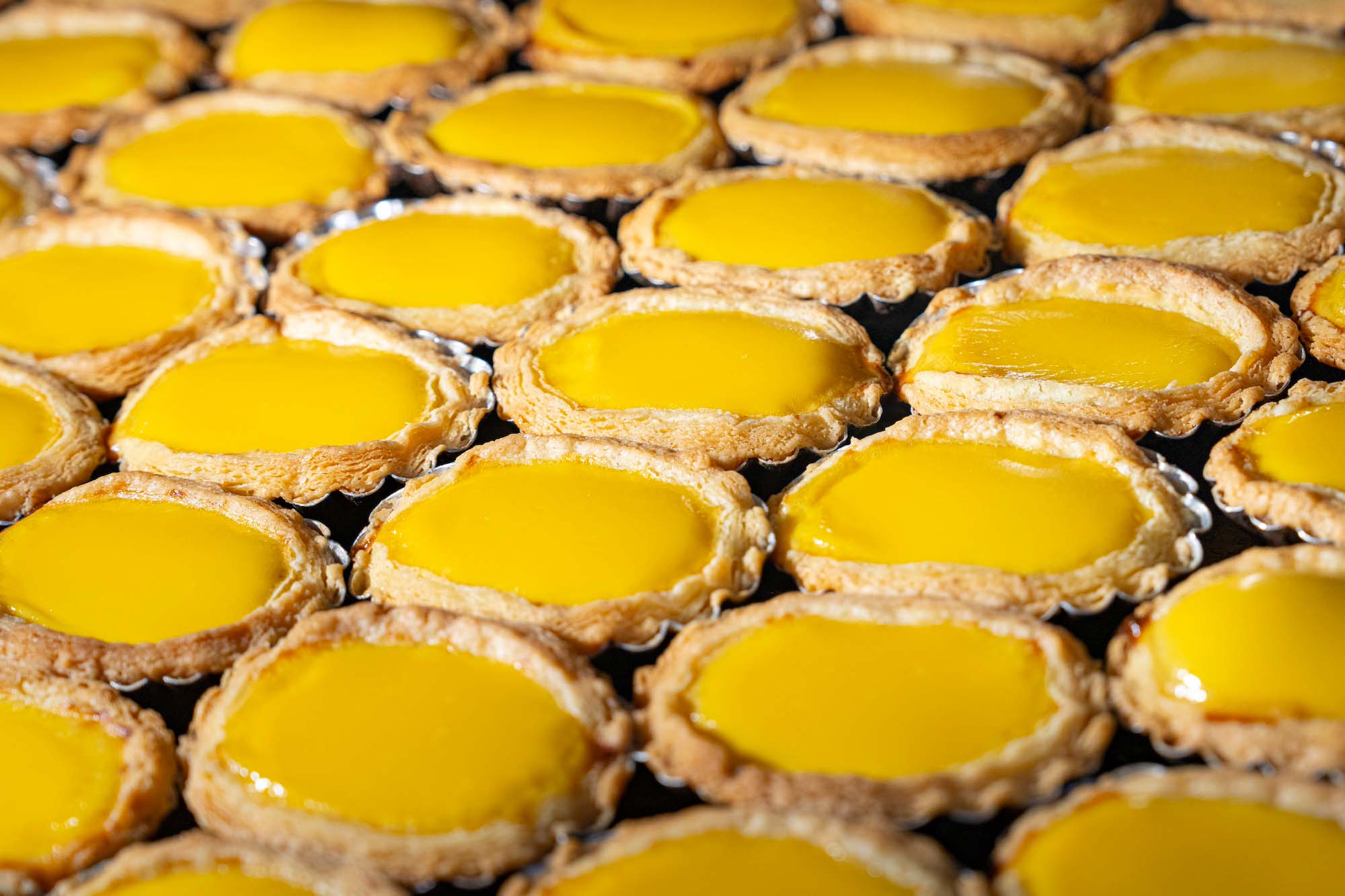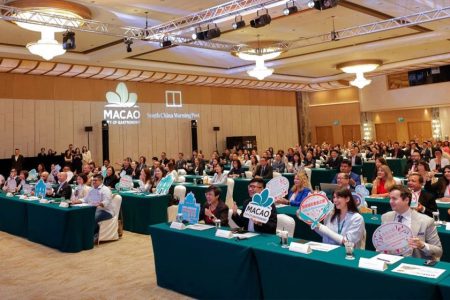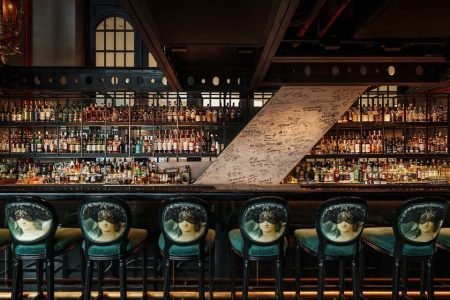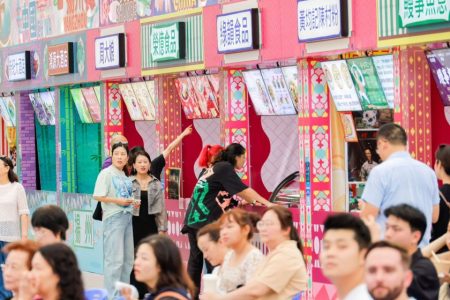To enter Chion Chau Café is to enter a good, old-fashioned south Chinese-style bing sutt. You’ll be greeted by bustle and chatter and a tall rack of sheet pans, laden with freshly baked pastries and buns – irresistible to passersby.
These days, the cafe’s customers are mainly locals. But pre-pandemic, its bright yellow egg tarts were intensely popular with tourists hailing from Japan. According to the bakery’s long-time owner, Leong Tat Veng, that quirk of clientele came courtesy of a Japanese travel writer.
About a decade ago, he wandered into Chion Chau and was blown away by the taste of Leong’s classic Chinese egg tarts. The veteran baker makes them extra flaky: no less than 243 sheets of pastry are layered beneath his creamy, custard filling.
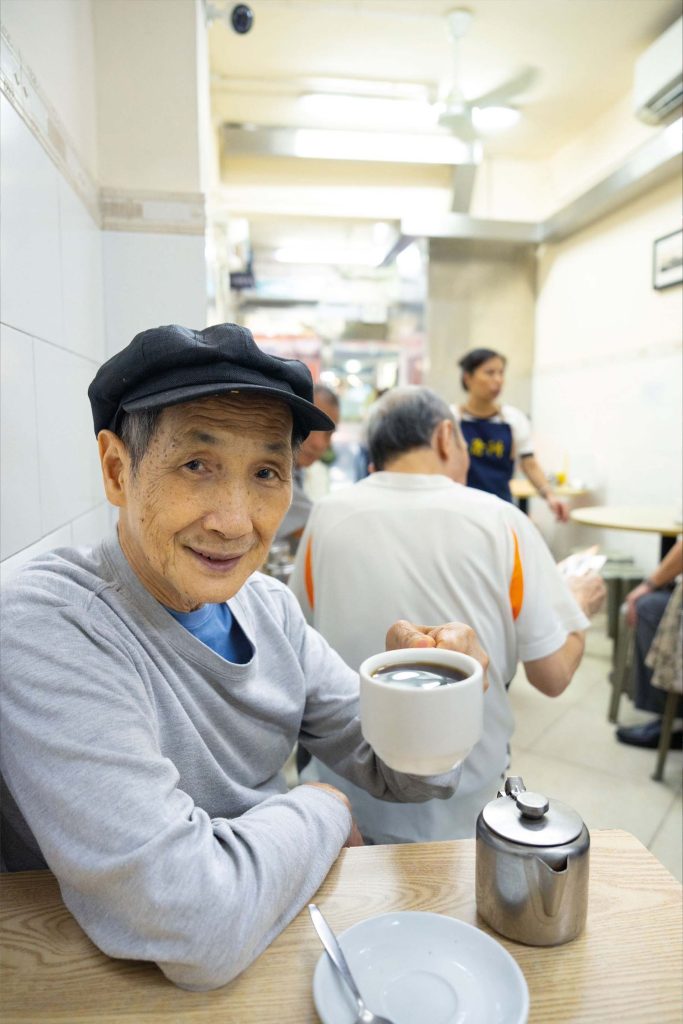
[See more: Bites of heritage: How do Macao’s egg tarts differ from Portuguese pastéis de nata?]
The Japanese writer featured Chion Chau Café in a guidebook for Japanese travellers visiting Macao. He also invited its owner to Japan – an opportunity Leong grabbed with both hands. “He asked me to bring boxes of my egg tarts to Japan, because he really wanted local people to taste them,” the 78-year-old chuckles. “It was my first time taking a flight and, when I landed, the egg tarts were still warm.”
Ask Leong what Chion Chau’s best pastry is, however, and Leong advocates for his wife cakes. This other much-loved classic consists of flaky pastry filled with candied winter melon and almond paste. Leong’s wife cakes are a hit with tourists from mainland China, he says. During last year’s Mid-Autumn Festival, a Chinese customer purchased 120 of the disk-shaped delicacies to take back to his friends and family. Leong shares this anecdote with pride.
From zero to hero: a baker learns his trade
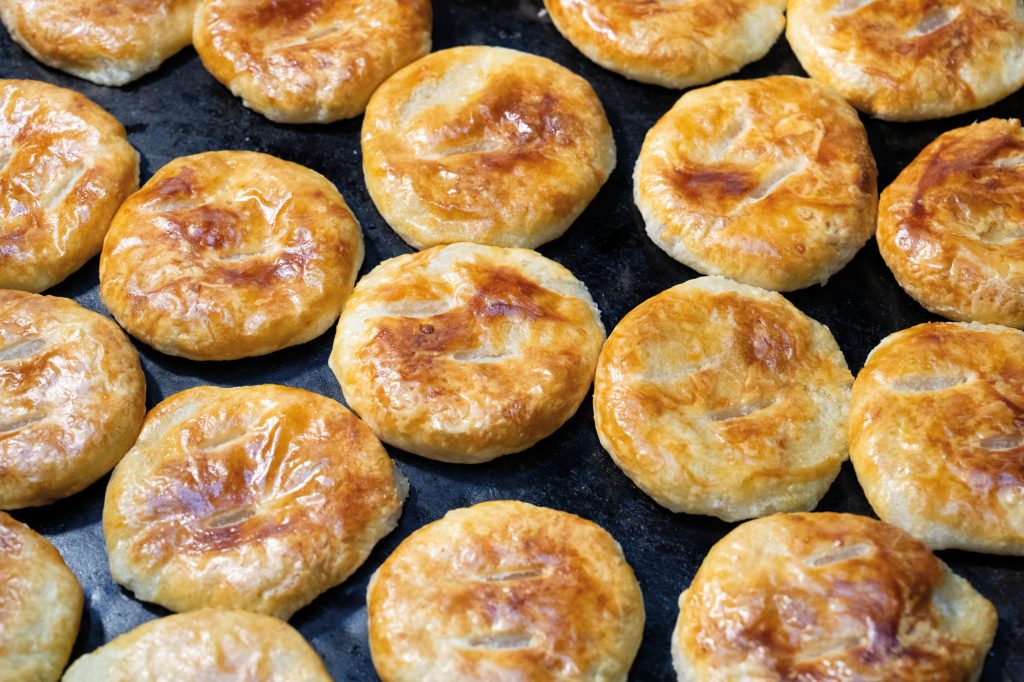
Leong hails from mainland China himself. He grew up in Shunde, Guangdong Province, and moved to Macao in the early sixties at just 17 years old. He landed a job at a bakery in the city’s northwest, where he learned the ropes of what would become a beloved profession.
[See more: Honest Bakery’s Venus Kwan on her journey from teacher to pandan chiffon cake]
A few years later, he joined his cousin at Chion Chau, which was already a well-established bing sutt (and formerly a roastery). In 1970, when Chion Chau’s then-owner relocated to Hong Kong, Leong scraped together enough money to purchase the business from him.
His first major challenge was a severe staff shortage. A 10-strong operation previously, many of the shop’s workers headed to Hong Kong with the old owner. Leong was left with just two staffers: one helped Leong with the baking side of things, the other managed the drinks counter.
Making coffees and assorted teas may seem easy, says Leong, but making them well requires skill. And when the bing sutt got busy, that job was too big for one person – who could be required to prepare 20 different orders per minute, plus remember who had paid for what. Leong admits he was not great at this fast-paced task himself, so soon hired another person to help his drinks guy out.
[See more: Where Macao’s chefs eat: If anyone knows the best places in town, they do]
In the early days, most of Chion Chau’s customers were unskilled labourers from mainland China. “During break time, they came and ate deep-fried buns filled with shredded coconut,” Leong recalls. “The buns were pretty much the same size as our plates. They were filling.”
The original premise was a three-storey building a few shops down from Chion Chau’s current site. When that old building was demolished in the nineties, Leong decided to secure new premises in the same area. “Most of our customers were locals and we wanted to stay in that [Rua de Cinco de Outubro] community,” he says.
The second iteration of Chion Chau is basic but well-scrubbed and functional, just like the first. “Back in the sixties, there was not such a thing as design and decoration,” says Leong. “As long as the café is clean, we are in business.” It’s a philosophy he’s maintained over the decades.
The next generation makes its mark
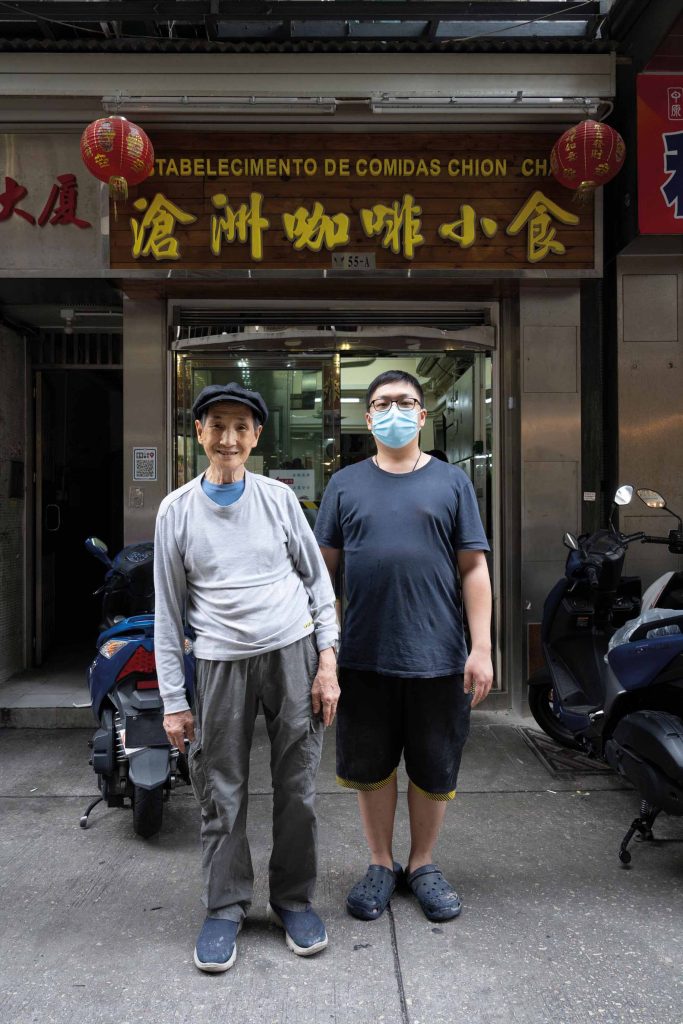
Leong’s youngest son, Leong U Chong, spent his childhood as dad’s little helper in Chion Chau’s kitchen. Even at home, he loved making cakes. The now-28-year-old remembers poring over his mother’s recipe books and developing a talent for Western fare: sponge cakes, cheesecakes and croissants. Whenever he ran out of ingredients, he’d run over to Chion Chau to stock up.
[See more: Passing the helm at Macao’s Cheong Kei Noodles]
When U Chong graduated from high school, he joined the Chion Chau team. “At that time, I wasn’t thinking of taking over the business,” he says. “I’d just finished school and thought my parents worked very hard, so I wanted to help them out.” The experience taught him the difference between baking as a hobby and baking as a profession.
The café was understaffed at the time; there was a lot of rushing down from the first-floor bakery to the ground-floor cashier and back up. There were also many recipes to memorise, cakes to make and customers to serve – all as quickly as possible. “When I baked at home, I could take my time,” U Chong says.
The hustle and bustle was stressful, he admits, and he did consider throwing in the teatowel. But a daily sense of achievement made U Chong stick it out. “I remember once, there was a crowd waiting,” he recalls. “I’d just finished a sheet pan of coconut tarts and thought I might as well take them down. Those customers simply marvelled at the sight of them. I could hear their ‘wows’ all the way from upstairs and they really meant a lot to me.”
[See more: Taste of Macao: Made in Macao sauces and condiments]
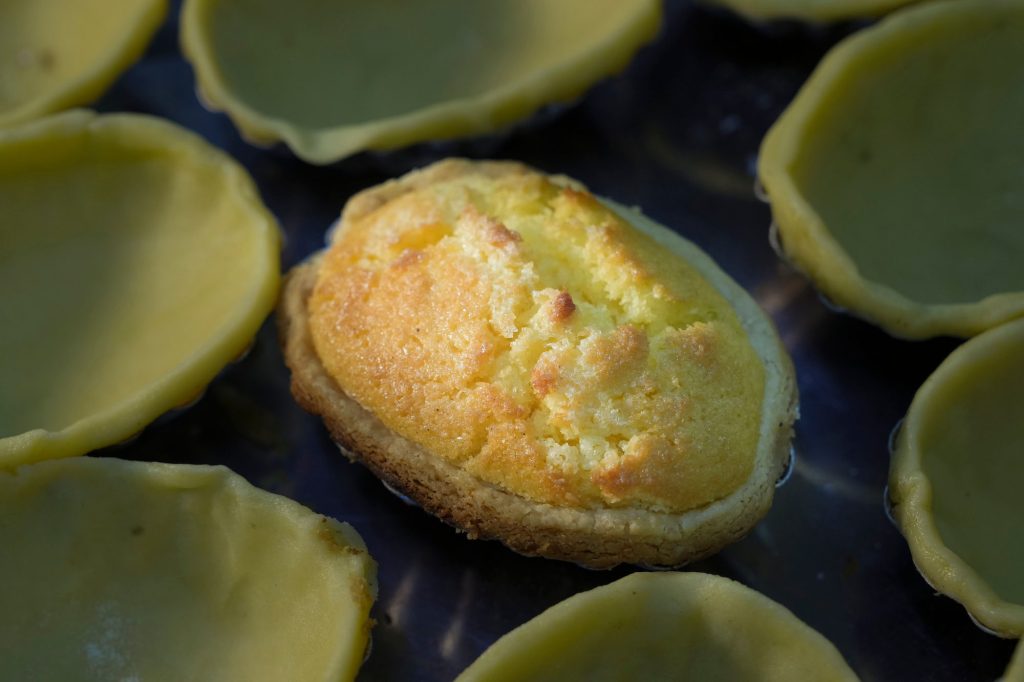
U Chong started running the business alongside his father in 2016. His favourite pastry is the textured pineapple bun – of which Chion Chau sells two sizes, big and small. “Other eateries put red bean paste into the big ones, but ours are filled with custard,” U Chong says. “As for the small ones, they don’t have any filling. People usually eat them by putting in a slide of butter.”
In addition to learning on the job from his dad, U Chong spent six months on a baking course run by the Macau Federation of Trade Unions. That gave him the confidence and skills to start revising Chion Chau’s long-standing recipes. U Chong has made the bread they sell softer, so elderly folk find it easier to chew. And his tarts have less sugar in them than Leong’s, as younger generations don’t like things too sweet.
Japanese tourists are no longer the cafe’s target audience. These days, “my goal is to attract the masses [local residents and mainlander tourists],” U Chong explains.
But there are some trends in Macao’s hospitality scene the young baker would like to see reversed. He remembers a strong community spirit back when he helped out as a child, something that appears to have faded. “Nowadays, people come in looking at their phones, eat fast, and then go,” U Chong says. “I hope, in the future, young people come in and have a chat instead of being distracted by social media. I hope they will treat Chion Chau as a place to enjoy having a rendezvous with their friends.”
